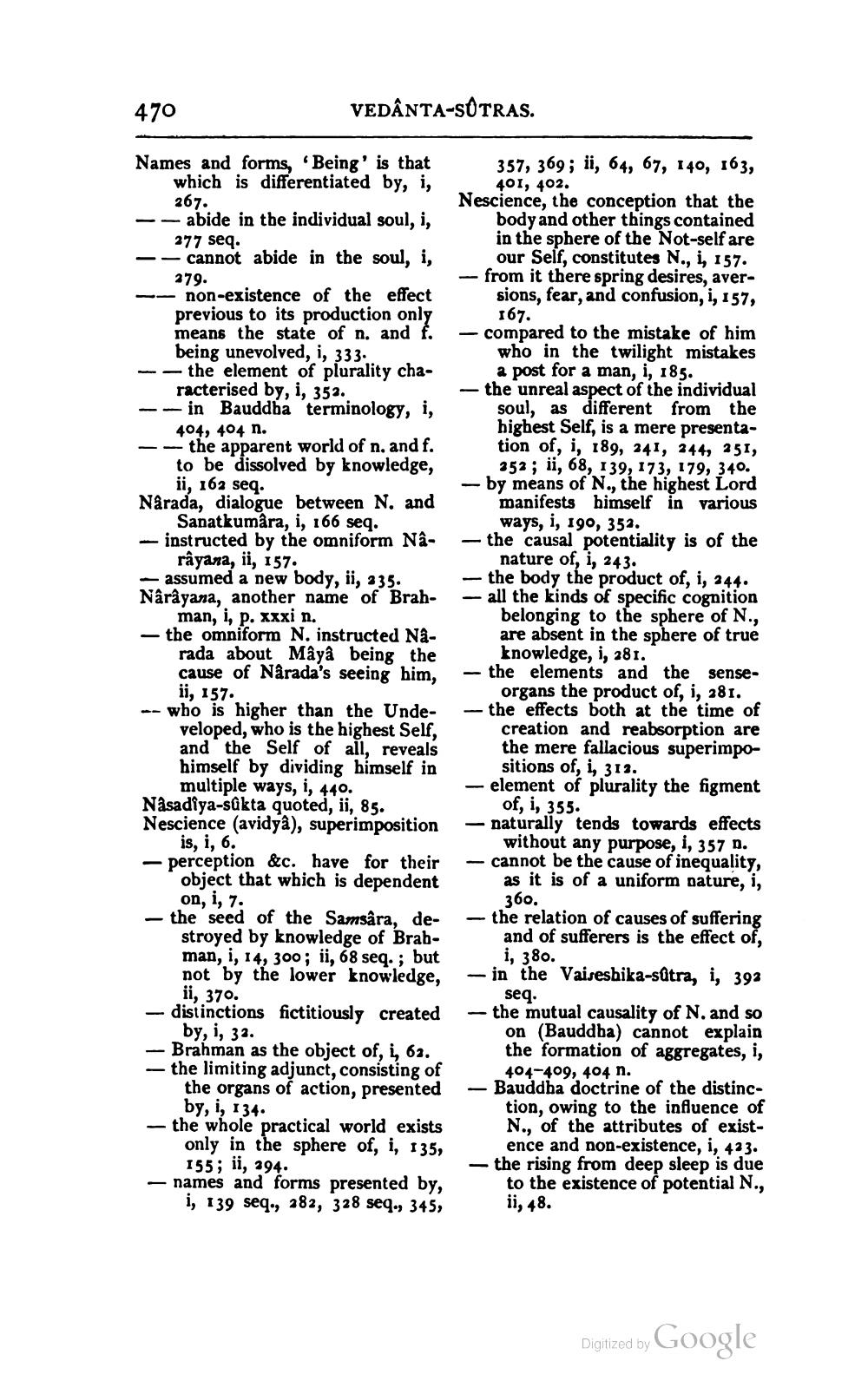________________
VEDANTA-SUTRAS.
470
Names and forms, 'Being' is that which is differentiated by, i, 267.
abide in the individual soul, i, 277 seq. -- cannot abide in the soul, i,
279.
non-existence of the effect previous to its production only means the state of n. and f. being unevolved, i, 333.
the element of plurality characterised by, i, 352. --in Bauddha terminology, i, 404, 404 n.
--the apparent world of n. and f. to be dissolved by knowledge, ii, 162 seq.
Nârada, dialogue between N. and Sanatkumâra, i, 166 seq. -instructed by the omniform Nârâyana, ii, 157.
- assumed a new body, ii, 235Nârâyana, another name of Brahman, i, p. xxxi n.
-the omniform N. instructed Nârada about Mâyâ being the cause of Nârada's seeing him, ii, 157. --who is higher than the Undeveloped, who is the highest Self, and the Self of all, reveals himself by dividing himself in multiple ways, i, 440. Nasadiya-sukta quoted, ii, 85. Nescience (avidyâ), superimposition is, i, 6.
- perception &c. have for their object that which is dependent on, i, 7. -the seed of the Samsâra, destroyed by knowledge of Brahman, i, 14, 300; ii, 68 seq.; but not by the lower knowledge, ii, 370.
- distinctions fictitiously created by, i, 32. -Brahman as the object of, i, 62. - the limiting adjunct, consisting of the organs of action, presented by, i, 134.
-the whole practical world exists only in the sphere of, i, 135, 155; ii, 294. -names and forms presented by, i, 139 seq., 282, 328 seq., 345,
357, 369; ii, 64, 67, 140, 163, 401, 402.
Nescience, the conception that the body and other things contained in the sphere of the Not-self are our Self, constitutes N., i, 157. - from it there spring desires, aversions, fear, and confusion, i, 157, 167.
- compared to the mistake of him who in the twilight mistakes a post for a man, i, 185.
the unreal aspect of the individual soul, as different from the highest Self, is a mere presentation of, i, 189, 241, 244, 251, 252; ii, 68, 139, 173, 179, 340. - by means of N., the highest Lord manifests himself in various ways, i, 190, 352.
-
-the causal potentiality is of the nature of, i, 243.
-
the body the product of, i, 244. - all the kinds of specific cognition belonging to the sphere of N., are absent in the sphere of true knowledge, i, 281.
-the elements and the sense
-
organs the product of, i, 281. -the effects both at the time of
creation and reabsorption are the mere fallacious superimpositions of, i, 312.
- element of plurality the figment of, i, 355.
-naturally tends towards effects without any purpose, i, 357 n. - cannot be the cause of inequality, as it is of a uniform nature, i, 360.
-the relation of causes of suffering and of sufferers is the effect of, i, 380.
- in the Vaiseshika-sûtra, i, 392 seq.
-the mutual causality of N. and so
on (Bauddha) cannot explain the formation of aggregates, i, 404-409, 404 n. -Bauddha doctrine of the distinction, owing to the influence of N., of the attributes of existence and non-existence, i, 423. the rising from deep sleep is due to the existence of potential N., ii, 48.
—
Digitized by Google




